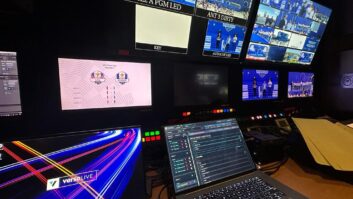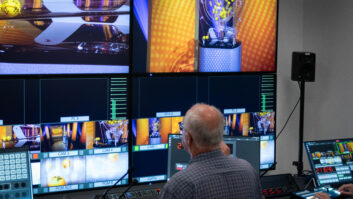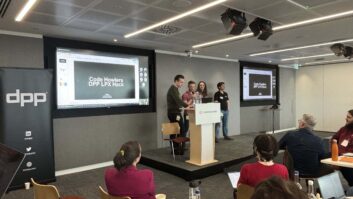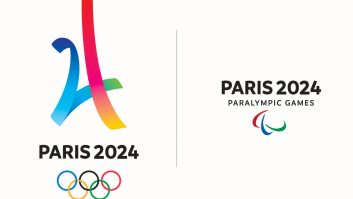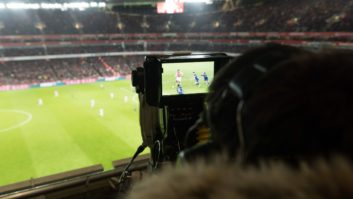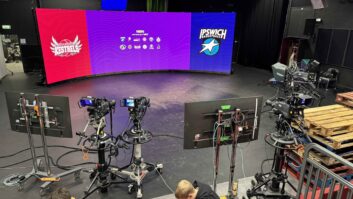On January 19, cinema audiences sat down to see actor Woody Harrelson break ground in the world of filmmaking with his live-to-cinemas feature film, Lost in London LIVE.
Written and directed by the versatile actor and co-starring Owen Wilson and Willie Nelson, and roughly 300 extras, Lost in London LIVE, based on Harrelson’s real-life misadventures, followed his character, covered with a single ARRI Alexa Mini, for about 100 minutes of difficulties and complications spread out over 14 actual London locations.
The proceedings, distributed by Fathom Events, were uplinked via satellite to 550 theaters throughout the company’s network, followed by a live Q and A.
The “live movie” was piped into theaters as a 1080i image stream with Dolby E sound at 9PM Eastern Time and concurrently throughout the US (plus a late night show in the UK). Harrelson promised that if the project failed, he will jump off the Waterloo Bridge into the Thames. No jumping was recorded.
A lot of this seems straightforward, until you’re drilling down into the specifics of pulling this all together
A new level of crazy
Co-produced by Ken Kao of Waypoint Entertainment, the film was inspired by critically-acclaimed German film Victoria, also all shot in one take. The makers of that film, however, took several passes at the action rather than sending it live to cinemas.
When Fathom CEO John Rubey and live producer Vicki Betihavas were interviewed before the event, the latter was overseeing rehearsals and still working on determining technical and logistical aspects of this head-spinning endeavor.
“We loaded in Sunday,” said Vicki Betihavas. “Tomorrow we have the synch tests. The development of the film itself has happened over several months” – still a fast pace for even a traditional theatrical feature – “and we’ve been planning the production for weeks. Now we’re finally testing and rehearsing.”
“When Woody Harrelson approached us with this concept last October,” said Rubey, “we thought it was one of the best ideas we’d ever heard. I don’t think anyone’s attempted anything as elaborate as this. We’ve done events multi-camera, one location,” he said of sports and musical presentations Fathom has been known for, “but one camera and 14 locations through the streets of London? Never done anything like it! We’re taking crazy to a whole new level. There might be technical glitches in it or whatever, but you have to embrace that!”
“A lot of this seems straightforward,” offered Betihavas, a veteran producer of complex, live events, “until you’re drilling down into the specifics of pulling this all together.”
Transmitting
Cinematographer Nigel Willoughby, whose credits include Downton Abbey, pre-lit the 14-location night shoot and was instrumental in working through the complex camera logistics, which required a single operator to capture the action and scripted moves with the Mini. The operator was entirely wireless – a first assistant pulled focus remotely and the image output (as Log-C 1080i) was sent wirelessly to the DIT, who added some colour balance live.
A Domo HD transmitter, supplied by London’s RF Broadcast, was built into a backpack which contained the transmitter, four batteries, and sound equipment, carried by a grip. The transmit backpack was connected to the Arri Alexa Mini by an umbilical cable.
Whilst the camera was recording on board, live video was transmitted through the transmitter and by a total of 54 antennas. The transmitter ran at just 100mW, relayed by a chase car running 4W for in-car scenes. The event marked the largest single RF camera job Broadcast RF has ever done.\

Betihavas admitted they were working with something of a “net,” if not a very sturdy one. A second Mini and operator followed along so there would be something to cut to should there be a problem with the A-camera but, depending on where they are in the story, this camera would be able to provide little more than a cutaway to some buildings. There was also a full tech rehearsal dead rolling off one of the Sony nonlinear playout systems that was used to play out the titles. Betihavas notes that the system is similar to the EVS setup frequently used on her other projects, but the production was unable to find an EVS system that could handle the 23.98 frame rate.
You’ve got to embrace what’s never been done before” “In terms of RF, the technology involved is more than Wimbledon
Live sound
Though shooting Lost in London LIVE was a daunting proposition, Betihavas noted that from her POV, the audio was even more so. Every speaking actor will be wirelessly miked. It is still to be determined if there will also be an omnidirectional 5.1 mike mounted to the camera.
There were approximately 54 receivers for dialogue and a sound mobile unit, housed with multiple ProTools workstations to play out music and then that audio will be relayed to a studio, where a mixer at a Studer mixing console will oversee the Dolby output.
This, of course, is not the type of live event on which Rubey and Betihavas have previously collaborated. Fathom has presented multi-cam music and sports events out of fixed venues with control rooms, but they describe Lost in London as being a “location film shoot.” Everything’s wireless and there’s no infrastructure. Betihavas has never faced the level of challenge for headset communications in any previous project.
“Beyond the RF for the actors,” she said, “The whole comms operation is enormous. We’ve got eight different comm channels. Engineers are in what would traditionally be called the ‘live gallery’ and there obviously has to be communication with the camera team and the script supervisors” – there’s one to cue the actors and one to cue the operator and assistants for camera choreography.
“Everyone doesn’t want to hear what everyone else is saying. There will be something like 200 radios and that alone is quite a complex operation. Just in terms of RF, the technology involved is more than Wimbledon or British Open golf.”
Getting onboard
Extending the concept that this is a movie, not a television broadcast, she added, “Usually, you think about title sequences months down the line. How do you open the show, close the show, how does music flow? Suddenly, we’re doing ‘postproduction’ at the same time that the structure of the film and the performances are being finessed.”
Before returning to rehearsals, Betihavas said, “I’ve got a bunch of very excited technicians. They’re all very seasoned and they’re all loving this challenge.”
“You’ve got to embrace what’s never been done before,” Rubey summed up. “The longer you’ve been in this business, the more you’re taught to avoid most of what we’re doing here. But when you have someone like Woody Harrelson – and he surrounds himself with top people who want to make the best film they can in a way it’s never been done before – you don’t second guess that. You get onboard.”

